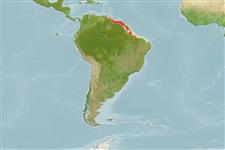>
Pleuronectiformes (Flatfishes) >
Cynoglossidae (Tonguefishes) > Symphurinae
Etymology: Symphurus: Greek, syn, symphysis = grown together + Greek, oura = tail (Ref. 45335); oculellus: From the Latin 'oculus' meaning eye and 'ellus' meaning little, referring to the small size of the eye.
Environment: milieu / climate zone / depth range / distribution range
Ökologie
seewasser demersal; tiefenbereich 7 - 110 m (Ref. 10879), usually 11 - 70 m (Ref. 10879). Tropical; 10°N - 5°S, 60°W - 35°W (Ref. 26268)
Western Atlantic: Guyana to NE Brazil.
Size / Gewicht / Alter
Maturity: Lm ? range ? - ? cm
Max length : 18.9 cm SL Männchen/unbestimmt; (Ref. 10879)
Life cycle and mating behavior
Geschlechtsreife | Fortpflanzung | Ablaichen | Eier | Fecundity | Larven
Munroe, T.A., 1991. Western Atlantic tonguefishes of the Symphurus plagusia complex (Cynoglossidae: Pleuronectiformes), with descriptions of two new species. Fish. Bull. 89(2):247-287. (Ref. 10879)
IUCN Rote Liste Status (Ref. 130435: Version 2024-2)
Bedrohung für Menschen
Harmless
Nutzung durch Menschen
Tools
Zusatzinformationen
Download XML
Internet Quellen
Estimates based on models
Preferred temperature (Ref.
123201): 25.9 - 28, mean 27.4 °C (based on 104 cells).
Phylogenetic diversity index (Ref.
82804): PD
50 = 0.5000 [Uniqueness, from 0.5 = low to 2.0 = high].
Bayesian length-weight: a=0.01122 (0.00514 - 0.02450), b=3.04 (2.87 - 3.21), in cm total length, based on all LWR estimates for this body shape (Ref.
93245).
Trophic level (Ref.
69278): 3.4 ±0.4 se; based on size and trophs of closest relatives
Widerstandsfähigkeit (Ref.
120179): hoch, Verdopplung der Population dauert weniger als 15 Monate. (Preliminary K or Fecundity.).
Fishing Vulnerability (Ref.
59153): Low vulnerability (13 of 100).
